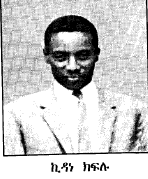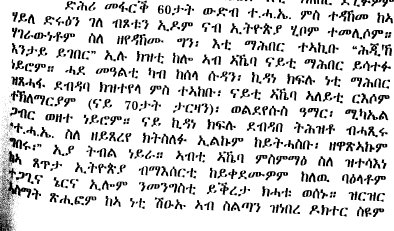THE JACK KRAMER PAPERS: HISTORICAL PERSPECTIVE (Part VII)
BY
Issayas Tesfamariam
PART SEVEN
Issayas: What was the importance of Kidane Kiflu in the Eritrean struggle. In other words, what did Kidane Kiflu symbolize?
Professor Berhe: Kidane landed in the midst of the turbulence that characterized the first decade of the Eritrean armed struggle. In the second half of the 1960s the armed struggle for Eritrean independence was undergoing severe growth pangs. Kidaneís writings (correspondences) show his concern about the problems faced by the movement and the need for positive reform and development. The leadership of the Front at that time did not welcome such views. Eventually he was murdered in cold blood. Alamin Mohamed Said in his book ìThe Ups and Downs of the Eritrean Revolutionî (1994), specifically states, ìThe Eritrean Liberation Front Ö executed 250 individuals based on religion and regional affiliation. Kidane Kiflu and Weldai Ghidey were two of them.î (p.26).
Issayas: What was your feeling when you heard that Kidane Kiflu was killed?
Minister Naizghi: I had just finished my studies in Russia and was getting ready to go to the United States for a Ph.D. From Russia I went to Rome and it was in Rome that I heard that Kidane Kiflu was martyred from Tsegai Kahsai. I was saddened. On the other hand, I decided to quit my studies and join to fight.
Issayas: What is the significance of the death of Kidane Kiflu?
Professor Berhe: Recent interview by Brig. General Ghirmay Mehari, serialized in Haddas Eritrea, confirms the previous word of mouth account of how the two (Kidane Kiflu and Woldai Ghidey) were murdered in cold blood in Kassala. They were lured to a certain Woldai Fikhakhís house for lunch. There they were literally butchered by ìfedayeenî, hiding under a bed. Later, the killers put the corpses in sacks, put them in a taxi and were on their way to Mt. Mikram to dump them away when one of the bodies fell off the car. (Hadas Eritrea, October 1, 2003). Kidane Kiflu was a learned man, a man of ideas and idealism. I have no doubt that his ideas contributed in shaping the future direction of Eritrean revolution. Kidane died an untimely death, in his twenties. His death should torture the conscience of his assassins, and the pusillanimous leaders who ordered his murder, that is those who are still alive, and assuming they have the conscience of a penitent murderer in his deathbed. But that is expecting too much.
Issayas: While I was working on this article/interview, coincidentally you were interviewed on Haddas Eritrea. Even though you have mentioned in detail your experience as a fighter in the newspaper, if you donít mind I would like to ask you a few questions.
Brig. General Ghirmay: There is no problem. I will be glad to.
Issayas: Did you know Kidane Kiflu?
Brig. General Ghirmay: No, I did not know him very well. But I have met him a couple of times.
Issayas: When was he killed?
Brig. General Ghirmay: He was killed along with Woldai Ghidey. I have pictures of both of them. If you need the pictures for your article I will let you use them. They were killed after the end of the Adobha Conference. The main aim of the conference was to unite the various divisions. Kidane and Woldai were working hard and believed that the struggle or the revolution should be united. Both of them were invited for lunch at Woldai Fekhakís home. Once there, they were butchered by the ìfedeyeenî who were hiding under a bed.
Issayas: A lot of people say that the killing of Kidane Kiflu and Woldai Ghidey was the breaking point for the later EPLF to split from the ELF. What do you think of the statement?
Find more information from Mr Berhan Belata interview with Eritrean Tv. Demtsi Hezbi 9 February 2013
Kidane Kiflu |
Woldai Ghidey |
Minister Naizghi: The split from the ELF had already started before the martyrdom of Kidane. Basically, Kidane was in Kassala with the understanding reached between him and Isaias Afwerki and Abraham Tewolde. Isaias and Abraham had already split with their respective comrades. Kidane Kiflu was in Kassala to coordinate the activities outside of the field. From Kassala he used to correspond with me, Aboi Woldeab Woldemariam, Hiruy Tedla and others about the conditions and situations of the field.
Issayas: Thank you for the pictures. In the Haddas Eritrea interview you mentioned that you and Wolderufael Sebhatu were sent to retrieve the documents of Kidane and Woldai Gheday after they were killed. What was the importance of those documents and where are they now?
Brig. General Ghirmay: They were very important documents. Wolderufael Sebhatu (who was martyred in Nakfa) and I were sent to get the documents from the house that was used as their office. Wolderufael knew the whereabouts and the importance of the documents because he used to work with them. You know, Wolderufael was supposed to have been killed with them but he was away at the time. Once we got to Kassala we got some of the documents but not all.
Issayas: In the interview with Haddas Eritrea, Brig. General Ghirmay Mehari stated that he and Wolderufael Sebhatu were sent to Kassala to collect the documents of Kidane Kiflu. What was the importance of these documents? Where are they now?
Minister Woldenkiel Gebremariam: The documents were very important. Kidane Kiflu was in Kassala and Kassala was the coordinating point with the field. He used to follow up the situations in the field and record them. They were very important historical documents. Some of the documents (letters) were sent to the field. With the situation that we went through in the field, it is hard to say where they are. Some documents were taken by Tekue Yhidego and etc. to Aden from Kassala. We used to have them with our Hafash Wudubat (Mass Organizations). After we went to the field we did not know the situation of the documents.
Minister Naizghi: The documents were very important. They used to describe the situations in the field. Who did what? Who got killed by whom ...etc. are the sort of things that were in the documents. We left some of the documents with our Hafash Wudubat (Mass Organizations) in Aden, Yemen. Later, we heard that the documents were stolen.
NEXT: FINAL PART (EIGHT). ìThe Battle of Halhalî (1968) with Mr. Jack Kramer, Professor Berhe Habte-giorgis and Dr. Tom Killion. Also, a sketched map and an audio clip of Mohammed Ali Idris from the ìKramer Papers 1968-1969.î
© Copyright 2001-2009 Shaebia.org [ Kidane Kiflu and the Jack Kramer Papers: Addendum Tuesday, 21 September 2010 08:11 Written by EritreaCompass




 source
source
Hello Awate team!
Yes, I consider still the awate website as the best among the Eritrean website. But this article is extremely biased and very fsr from the reali8ty we all exercised during our childhood!!!! How can you write “… Nehnan Elamanan came with allegations of grisly murders committed by what it called the “Jihadist” ELF against Christians; and after more than forty years, the allegations still circulate as truth among Isaias’ supporters. With time, the unsubstantiated allegation became urban legend, elevated to a myth, and further deepened the mistrust among Eritreans and to this day continues to divide Eritreans. …” The truth is: ELF was even worse than the jihadist. I myself had an explainable fear from ELF. They have slaughtered mostly christiens from the highland; the sistr of my grand mother was burned wiht her full assets. I participated as a teenager the funeral day of the beloved aunt of my father. The most interesting thing is, she was a famer who could neither write and read – just a very simple woman! This is only the pick of the berg/mountain.
I write this fact even if I hate existing regime in Eritrea. Facts remain facts!!!
You could have reasoned it out only as a starting and difficult initial phase of our struggle like every START made ELF many failure . Otherwise you go the risc to degradate the reputation you have earned.